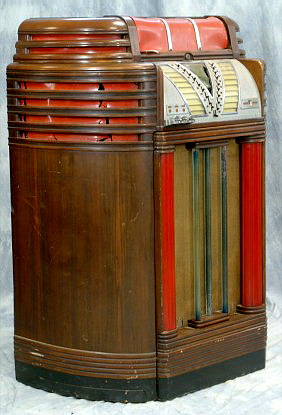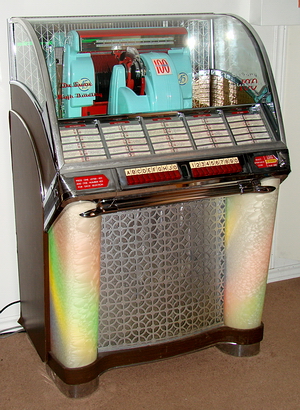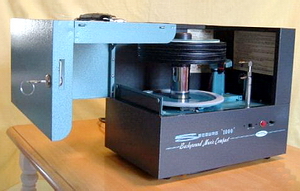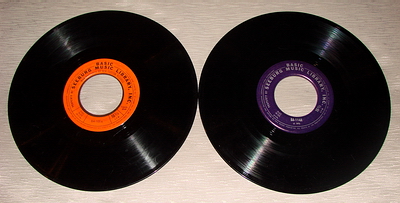|
A History of 16-RPM Records, Part Three
The Seeburg Background Music System
by Mike Dicecco

|
|
A 16 2/3 RPM Seeburg record from 1966. Note 'the place in use date' of "10-1-66". The number "BA-105 A" refers to where in the record stack within
the jukebox that this disc was to be placed. Seeburg was very particular about the order in which the records were to be arranged!
(Author’s collection)
|
|
|
In our last article (Audio Books), we examined the development and use of 16 RPM records,
mainly as they applied to home use. We will continue our look at this obscure record speed, by concentrating on the commercial application in the Seeburg
Background Music System (BMS).
You may recall from my previous articles on this subject that there was minimal standardization of the 16 2/3 RPM format. Some were pressed as 7" singles with 3"
centre holes and no paper label, others were pressed looking similar to a 45 RPM single. Still others were issued as 10" or 12" albums complete with sleeve
graphics. Most of these unusual configurations had vanished by the early 1960s.
The Seeburg BMS, however, was the greatest exploitation of the 16 RPM speed. They pressed more records in their unique 16 RPM format than any other 16 RPM
disc manufacturer, and utilized this speed for more than 30 years.
A Brief History of The Seeburg Corporation
Justus P Seeburg (Sjoberg) was of Swedish descent and founded his company in 1902 with capital of his own. His earliest products were coin-operated pianos,
which later evolved into "Orchestrions". These were powered pneumatically by electrically operated bellows. With the deposit of a coin, a patron was entertained
by a player piano that was accompanied by a variety of instruments: snare drum, flute, mandolin, cymbals, and violin. The company became the leading player
piano manufacturer by 1920.

|
|
A 1918 Seeburg Orchestron, essentially a mechanical orchestra operated by a coin.
(Courtesy of Mechanical Music Digest)
|
|
|
The introduction in 1926 of the Brunswick Panatrope was indeed a technological breakthrough in sound quality. For the first time, phonograph records were able
to be played with considerable volume and wide range sound (not possible with acoustic reproduction). Justus Seeburg recognized the importance of this development
and by 1927 had discontinued production of "Orchestrions". With the arrival of electrically recorded discs and electrical playback, Seeburg manufactured one of
the first "automatic phonographs" or jukeboxes. It was a non-selective model that played 8 records. The 1930s saw a proliferation of Art Deco jukebox masterpieces,
as Seeburg competed with other manufacturers, such as Wurlitzer and Broccoli for market domination. During this period, Wurlitzer was always the leader, with
Seeburg usually in the number three position.
Various selector mechanisms were tried before settling on one that used a system of sliding trays to change the records. In spite of the Depression, the market
expanded greatly. Prohibition had been repealed and liquor was now flowing in many local taverns. These establishments needed cheap entertainment, and jukeboxes
fitted the need perfectly.
Seeburg was often a company that would experiment with new technology. They were the first to create a "light-up" machine, the "Symphonola Classic" of 1938.
This used low-wattage bulbs behind red translucent plastic panels. The effect was so stunning that their competitors scrambled to come out with similar cabinets.
Seeburg was also the first to offer "Wall-o-Matic" systems to restaurant patrons. This was a wired selector box that was wheeled from table to table. Later on,
the system was developed so that permanently mounted wall-boxes were at each table. These are fondly remembered today, and the most recognized is the model 3W1.
Perhaps the greatest development that Seeburg made in its history is that of the "Select-o-Matic" mechanism, first used in the 1949 Model M100A. Up until this time,
most jukeboxes had 20 to 24 selections, playing only one side of each record.

|
|
The Seeburg Symphonola of 1938 was one of Seeburg's early attempts at creating a jukebox with lit up plastics,
to help with play appeal. The lack of a visible mechanism, though, hurt the sale of these machines, and reduces their collector value today.
|
|

|
|
The 1953 Seeburg HF (High Fidelity) Model G, was one of the first jukeboxes to play the new 45 RPM record. Fifty records gave 100 selections,
and often had several 3W1 Wallboxes connected to it in a diner or similar setting. This machine, (and others similar to it) was often used in
the television series, "Happy Days" and as such has become synonymous with that show and 1950's youth.
(Author’s collection)
|
|

|
|
The Seeburg Model R of 1954 continued the chrome and glass theme, and is a highly sought jukebox among collectors today.
(Author’s collection)
|
|
|
The "Select-o-Matic" held 50 records, playing both sides, for a total of one hundred tunes. In 1950, Seeburg was the first jukebox manufacturer to take a chance
on formatting their mechanism to play the new 45 RPM single. It was a gamble, as there was no guarantee that the format would survive or ever surpass the beloved
78 RPM record. By the mid 1950s, Seeburg was the undisputed leader in jukebox manufacture. The glass and chrome machines, with visible mechanisms, are highly
collectible and spark warm memories for many. However, by the early 1960s, the role of the jukebox was beginning to wane (especially with the advent of television).
The machines took on much more of a background role, losing their glitter and curves, and began to look like cigarette machine consoles!

|
Seeburg’s first attempt at creating a background music system. This model was created by putting two 100-play 78 RPM jukebox mechanisms together,
for a total of 200 non-selective sides. It was intended to be used for commercial applications in offices and factories. Later the units were re-designed
for home use. (Courtesy of Seeburg Ed’s website)
|
|
|
Development of a New Product and Service
Seeburg began testing the market for library-type record playing systems in 1948, calling them "Seeburg Industrial Commercial Music". They put two of their 100- play
78 RPM jukebox mechanisms into one cabinet, and sold them to well-to-do clients. Frank Sinatra was one of the first to purchase. The units were later available as
200-play 45 RPM models, and were popular in the 1950s, especially with celebrities such as Elvis, Nat King Cole and the like.
In the late 1950s, Seeburg sought to expand their product line, and saw a niche for background music in commercial establishments such as restaurants and department
stores. Their solution was a totally new 16 RPM record format, which would work only on their unit. The first BMS (Background Music System) was introduced in 1959,
the Model BMS "1000" (later referred to as "BMS 1"). It used much of the machinery and technology that had been developed for Seeburg’s jukeboxes.
It boasted the following exclusive specifications:
| •
|
A high fidelity 16 2/3 RPM, 9" record with a 2" centre hole, that could hold up to 40 selections
on one record and play for about 40 minutes or more per side. The groove was extremely fine, at 420 lines per inch, and a 0.5 mil stylus was used (vs. 1.0 mil
for regular mono microgrooves, and 0.7 mil for stereo). The cartridge was the two-sided Red Head model that was utilized in their jukeboxes (but with a smaller
diameter stylus to play these very finely grooved records).
|
| •
|
The system was referred to as the "Seeburg 1000", since the unit could play 25 records,
holding 1000 selections, without title duplication (25 records with 40 selections each = 1000). Average play time for the stack of 25 records was 37.5 hours.
Certainly a technical feat in its time!
|
| •
|
The Model BMS 1 (and later BMS 2) was a fully-contained unit that held the unique record changer,
a 12-watt RMS amplifier (capable of powering up to 50 individual speakers, in addition to the internal 6" x 9" speaker), as well as provisions for use as a
public address system or conventional phonograph playback. It was deemed compact, and measured 22" x 14" x 12", weighing "only" 51 lbs.
|
| •
|
At the end of the cycle, the unit would re-stack the records by having the turntable push the stack
up, and begin the playback process all over. (It is supposed to be fascinating to watch).
|
| •
|
Although Seeburg often referred to the records as "High Fidelity", I personally have found them
to not live up to the hype. The bass response is suppressed so as to allow minimum groove width and thereby maximum length of the recording. The treble response
appears to fall off in the 6000 Hz range.
|
Introductory price for the BMS 1 was $695 (In comparison, at the time, a new console television was about $250. A typical new jukebox was $1200). A second
stripped-down version was the BMU 10, which looked the same as the BMS 1, but had no internal amplifier, so it had to be plugged into an existing public
address system. Later on, the last version released was a much smaller model introduced at $495, the BMC1 (Background Music Compact). This was very plain,
being a vinyl covered box, and was intended to be kept out of sight, again needing its own amplifier system (see photos).

|
The Background Music Compact was the lower end model, with a plainly designed cabinet, designed to be placed out of view of staff.
It did not have an internal amplifier, and as such had to be hooked up to an existing system. In general, these 16 RPM mechanisms are very reliable.
The only problem for restorers is that the rubber wheel which drives the records tends to get hard with age. That plus the slow 16 2/3 RPM speed
contribute to noticable wow and flutter! (Courtesy of Tony Miller website)
|
|
|
A revised model, BMS 2 was introduced in October 1963, and was much fancier than the BMS 1 that it replaced. It was designed to be in full public view, as
opposed to hidden away in a back room. A lighted window (with locked door) allowed the records to be fully visible. Another major technological advancement
was the use of a fully transistorized amplifier, especially since Seeburg was still using tubes in their jukeboxes (this too would change in 1964). The BMSs
were sold to music vendors, not the public, and it was more than a 'behind the scenes phonograph'. It was a true "system" that required frequent purchase
(or rental) of the software from Seeburg, thus ensuring a steady flow of income generated.
An interesting "accessory" was the SABMC2 Background Automatic Music Center. This was a cabinet designed to hold three BMS 2 units, and incorporated a timer.
It was used for either changing the variety of background music, supplying an incredible variety, or for funnelling three different types of music to three
different sections of a complex or company (for example, different music for a company’s office workers vs. factory workers).
Distribution of the system and records was very specific and unique. It was primarily leased to end-user businesses by Seeburg-appointed operators and sound
contractors, and paid for by the month. The cost of the service included new records being mailed out each month to the client, and old or unwanted records
were to be exchanged and returned to Seeburg (to be destroyed). The cost of the monthly service also included public performance ASCAP/BMI fees paid for
commercial music use.
Seeburg had special pressing arrangements with Columbia (and later RCA, then Capitol) for the manufacture of their unique records. Various types of music
were classified according to label colours and to suit the desired musical effect. It is not clear if the recordings were taken from the major record companies’
backlogs or were commissioned by Seeburg. In either event, they were made by unknown and unaccredited musicians.

|
The BMS-2 was the most deluxe version of the system, with fully integrated transistorized amplifier and a nicely designed cabinet (with visible mechanism window).
This was designed to be on display so staff could see it playing. Commonly referred to as "the microwave" model.
(Courtesy of Jukebox-World website)
|
|
|
The orange label was the "Basic Library" and had medium average tempo "completely instrumental, balanced musical content. Wide variety as to style and size
of orchestra, includes all latest suitable show tunes and pops. Designed for: offices, banks, restaurants, savings and loan associations, stores, supermarkets,
drugstores, shops, and airports".
The blue label series was "average tempo: Medium Slow. Completely instrumental, large orchestras. Full bodied, smooth, melodic music. Emphasis on stringed
instruments. Predominance of show tunes, great standards, waltzes. Pure 'atmosphere' music. Designed for prestige: department stores, hotels, motels, salons,
shops, restaurants, night clubs, country clubs, cock-tail lounges".
The third category was the maroon label "Industrial Library": "Average tempo, medium fast. Predominantly instrumental, with a light seasoning of great vocals.
An occasional polka and march. Emphasis on popular music. Minimum of stringed instruments. Unusually rhythmical. Over-all lively character but never rock 'n' roll.
Designed for industrial plants only". This up-beat music was designed to help workers be more productive! (Quotations are from the original product sales
literature booklet).
The series title names were later changed to "Lifestyle, Penthouse, and Upbeat" in 1979.
The library was quite large and was updated every three months with 5 new records (200 selections) initially, then to seven new records according to record
box containers issued in 1966. A Christmas series was also created, that included festive songs intermingled with regular selections.
Seeburg BMS Record Return Instructions
The following instructions were listed on the cartons of new 16 RPM records that Seeburg supplied for their operators. Note the clear and precise rotation
of a portion of the stack of records in the machine. Even the specific order on the machine is dictated. Penalties were imposed when records were not returned
to the factory (where they were destroyed). Still, there are many copies of these 16 RPM records available on the used record market, so the incentives for
returning were perhaps not severe enough! Since the Background Music Systems played only custom-manufactured 16 RPM records, the end-users had no option but
to comply with Seeburg’s instructions, or else they would quickly get tired of hearing the same selections on their machines!
IF SEAL IS BROKEN, THIS PACKAGE CONTAINS USED RECORDS
INSTRUCTIONS
|
| •
|
These five records replace five similarly numbered records in a Basic Library.
|
| •
|
Quarterly replacements must be executed in all libraries.
|
| •
|
Remove 25 records from mechanism; place on clean surface;
DO NOT TOUCH RECORD GROOVES.
|
| •
|
Extract five old records (similarly-numbered) and replace with these five Quarterly Replacement records.
|
| •
|
Place five old records in this carton and mark carton "USED RECORDS".
|
| •
|
Re-stack 25 records on mechanism in proper numerical order (1-25) with all "A" sides facing downward,
bottom record facing UP.
|
| •
|
Dealer returns all "USED RECORDS" to his distributor; distributor returns them, together with
his own, to Seeburg Music Library Inc. Used records may be returned in bulk, (without sleeves, etc) – they will never be re-issued.
|
NOTE CAREFULLY: Distributor must return records to Seeburg Music Library Inc the exact number
of "USED RECORDS" as he has received "Quarterly Replacements" within 30 days. It is his responsibility to get them back promptly from his dealer.
For each such "USED RECORD" not returned within 30 days, distributor’s monthly music fee will be increased by twenty-four cents (.24).
|
|
|
|
Operation Of The Record Change Mechanism
Harold Hagen in his book, Dr. Know-It-All’s 2nd Seeburg Reference (page 105), does an excellent job of describing the manner in which the mechanism
played and operated, without human intervention; 25 records on a continuous basis. Again, Seeburg had years of experience and leadership in the jukebox business,
so they were able to engineer a mechanism that was extremely reliable and easy to utilize.
"The (record changing) mechanism was specially designed for the Background Music System. It was quite ingenious and interesting to watch in action.
The twenty five records are placed on the top of the spindle, with a weight on top of them. A set of fingers on the spindle holds them in position.
When put into operation, the tone-arm first plays the lower side of the bottom record. When this side is finished, the record drops about an inch and a half,
and the tone-arm plays the top side of the same record. After this side plays, the record drops to the bottom of the spindle, and the lower side of the next record plays.
The unique part of the design is that the spindle is divided into two sections, both rotating continuously in opposite directions (the reason for this is so
that it could play the reverse side of the record in the proper direction, once called upon).
There is a feeler to see if there are any records remaining at the top of the spindle. Eventually, after all twenty-five records are played, the mechanism must
stop and raise all the records to the top... the mechanism pauses and an arm raises all the records to the top to start the cycle all over again.”

|
|
The Seeburg 3W1 wallbox was first manufactured in 1949 and used up until the early 1960's. Most people who attended a diner during this period, would be
familiar with this device. The wallbox does not play the music itself, but is hooked up to a jukebox on location. Money is put into the wallbox, and
selections made from here. Seeburg’s dominance of the jukebox market enabled them to diverse into the background music field.
(Author’s collection)
|
|
|
Recall that this entire process (playing 25 records) took approximately 37 1/2 hours!
If the reader has access to a computer, I strongly suggest that you check out You-Tube, under Seeburg Background Music System, and see one in operation for
yourself. It’s very interesting.
Demise
The BMS was extremely reliable and served its clients well for over 30 years. It was relatively inexpensive to rent, and there was a steady supply of new selections
available on a continuous basis. Today most of us would take for granted having unlimited music available but, in hind-sight, Seeburg truly had a remarkable system
that held a captive market in terms of its software! The last sets of records were issued in 1986, and the program was discontinued. But what led to this termination?
There were a few reasons.
Seeburg eventually switched to microwave satellite transmission (like their competitor Muzak), so as to offer a greater variety of music without the physical hassle
of exchanging phonograph records. Later on this type of transmission was sent over the Internet.
With microwave signals, there were typically 35 to 60 channels available, with only about 3 being "elevator" music. The business-owner clients can now custom-tailor
the mood they want to create, with the flick of a few buttons.
People’s tastes have changed too, in which most want to hear the original song by the original artist. IPods and cell phones now compete for attention.
Muzak, DMX, Music Choice, Play Network and the commercial arm of Sirius/XM satellite radio are the major providers of background music systems today.
Seeburg went out of business in the mid 1990s (mainly a result of the jukebox industry slowly collapsing, starting in the early 1970s).
Conclusion

|
|
Two 16 2/3 RPM Seeburg records. The left one is from 1966, the right from 1974. The colour of the labels changed over time, but the set up remained the same.
The records were originally pressed by Columbia, then RCA, later Capital.
(Author’s collection)
|
|
|
The Seeburg Background Music System was a technological leap that filled a niche market. This was the first and only successful application of 16 RPM records
that were specifically designed with this one purpose in mind.
BMS "1000" units will sometimes show up for sale on e-Bay and other venues. Prices are usually in the $200-$700 range, with records going for $10 and up,
depending on condition. Christmas selections appear to be the most popular and command higher prices (more tolerable music, I guess!). In comparison with
Seeburg jukeboxes, the BMS has much lower interest and demand. Although the changer mechanism is unique, it is the predominance of "elevator" music that has
prevented these units from becoming very collectible, nor are they ever expected to be in the foreseeable future.
Still, this 16 RPM system was very successful for three and a half decades, and delivered what it was supposed to: reliable, inexpensive background mood
music for a variety of patrons in a wide range of business establishments. Most other 16 RPM formats lasted less than 5 years each, so the BMS was clearly
the most prolific use of the speed, and will go down in phonographic history as such.
|